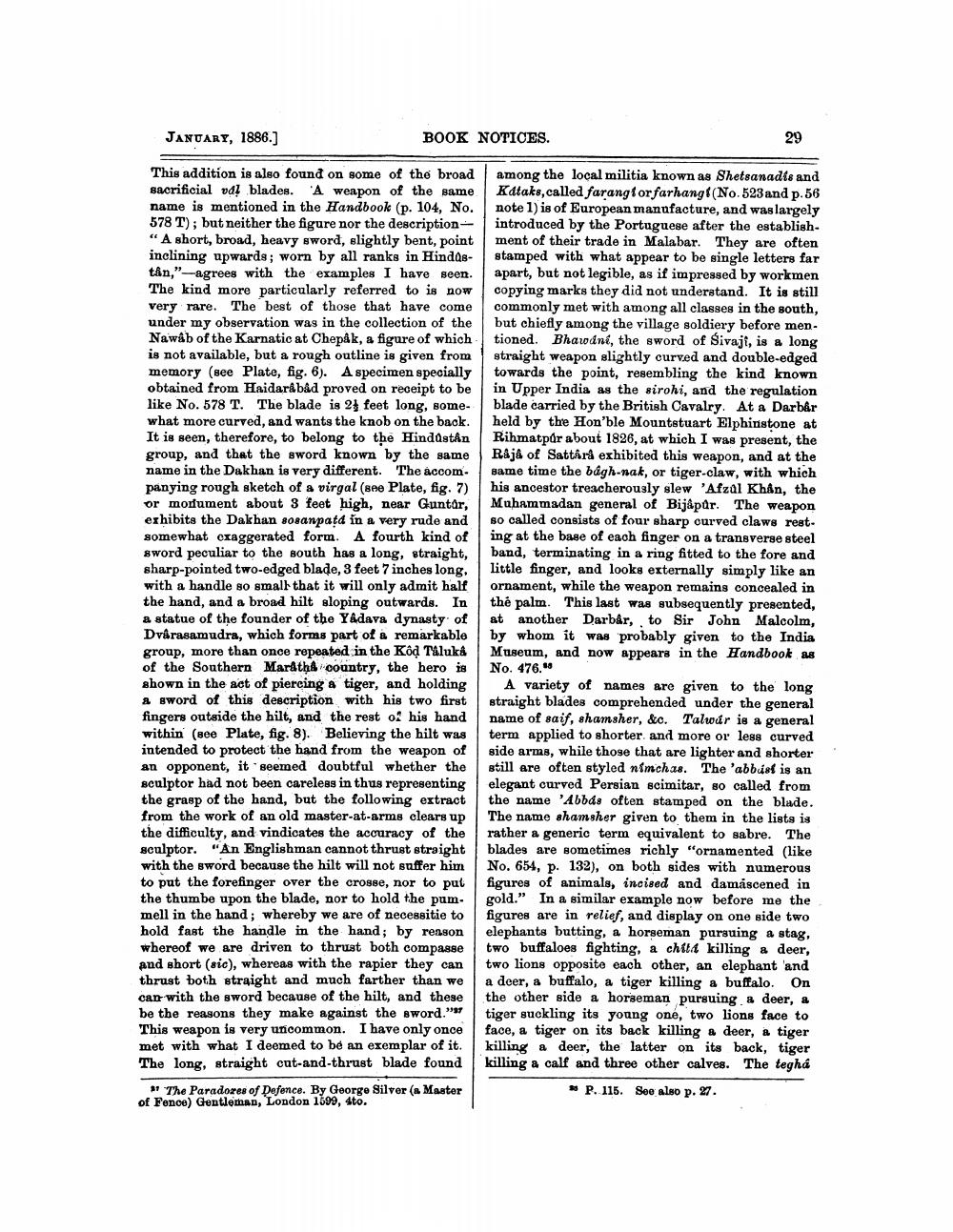________________
JANUARY, 1886.]
BOOK NOTICES.
29
This addition is also found on some of the broad sacrificial od! blades. 'A weapon of the same name is mentioned in the Handbook (p. 104, No. 578 T); but neither the figure nor the description"A short, broad, heavy sword, slightly bent, point inclining upwards; worn by all ranks in Hindastan,"-agrees with the examples I have seen. The kind more particularly referred to is now very rare. The best of those that have come under my observation was in the collection of the Nawab of the Karnatic at Chepâk, a figure of which is not available, but a rough outline is given from memory (see Plate, fig. 6). A specimen specially obtained from Haidarâbâd proved on receipt to be like No. 578 T. The blade is 2 feet long, some what more curved, and wants the knob on the back. It is seen, therefore, to belong to the Hinddstan group, and that the sword known by the same name in the Dakhan is very different. The accom panying rough sketch of a virgal (see Plate, fig. 7) or morlument about 3 feet high, near Guntur, exhibits the Dakhan sosanpatd in a very rude and somewhat exaggerated form. A fourth kind of sword peculiar to the south has a long, straight, sharp-pointed two-edged blade, 3 feet 7 inches long, with a handle so small that it will only admit half the hand, and a broad hilt sloping outwards. In a statue of the founder of the Yadava dynasty of Dvarasamudra, which forms part of a remarkable group, more than once repeated in the Kod Taluka of the Southern Marath country, the hero is shown in the act of piereing a tiger, and holding & sword of this description with his two first fingers outside the hilt, and the rest of his hand within (see Plate, fig. 8). Believing the hilt was intended to protect the hand from the weapon of an opponent, it seemed doubtful whether the sculptor had not been careless in thus representing the grasp of the hand, but the following extract from the work of an old master-at-arms clears up the difficulty, and vindicates the accuracy of the sculptor. "An Englishman cannot thrust straight with the sword because the hilt will not suffer him to put the forefinger over the crosse, nor to put the thumbe upon the blade, nor to hold the pum. mell in the hand; whereby we are of necessitie to hold fast the handle in the hand; by reason whereof we are driven to thrust both compasse and short (sic), whereas with the rapier they can thrust both straight and much farther than we can with the sword because of the hilt, and these be the reasons they make against the sword." This weapon is very uncommon. I have only once met with what I deemed to be an exemplar of it. The long, straight cut-and-thrust blade found
among the local militia known as Shetsanadis and Kataks,called farangtor farhang((No.523 and p.56 note 1) is of European manufacture, and was largely introduced by the Portuguese after the establishment of their trade in Malabar. They are often stamped with what appear to be single letters far apart, but not legible, as if impressed by workmen copying marks they did not understand. It is still commonly met with among all classes in the south, but chiefly among the village soldiery before mentioned. Bhawodni, the sword of Sivaji, is a long straight weapon slightly curved and double-edged towards the point, resembling the kind known in Upper India as the sirohi, and the regulation blade carried by the British Cavalry. At a Darbar held by the Hon'ble Mountstuart Elphinstone at Rihmatpár about 1826, at which I was present, the Raja of Sattará exhibited this weapon, and at the same time the bagh-nak, or tiger-claw, with which his ancestor treacherously slew 'Afzal Khan, the Muhammadan general of Bijapur. The weapon so called consists of four sharp curved claws resting at the base of each finger on a transverse steel band, terminating in a ring fitted to the fore and little finger, and looks externally simply like an ornament, while the weapon remains concealed in the palm. This last was subsequently presented, at another Darbár, . to Sir John Malcolm, by whom it was probably given to the India Museum, and now appears in the Handbook as No. 476."
A variety of names are given to the long straight blades comprehended under the general name of saif, shamsher, &c. Talwar is a general term applied to shorter and more or less curved side arms, while those that are lighter and shorter still are often styled nimchas. The 'abbusi is an elegant curved Persian scimitar, 80 called from the name 'Abbde often stamped on the blade. The name shamsher given to them in the lista is rather & generic term equivalent to sabre. The blades are sometimes richly "ornamented (like No. 654, p. 132), on both sides with numerous figures of animals, incised and damascened in gold." In a similar example now before me the figures are in relief, and display on one side two elephants butting, a horseman pursuing a stag, two buffaloes fighting, a chit 4 killing & deer, two lions opposito each other, an elephant and a deer, a buffalo, a tiger killing a buffalo. On the other side a horseman pursuing a deer, a tiger suckling its young one, two lions face to face, a tiger on its back killing a deer, a tiger killing a deer, the latter on its back, tiger killing a calf and three other calves. The teghá
* P. 115. See also p. 27.
» The Paradores of Defence. By George Silver (a Master of Fenoe) Gentleman, London 1599, 4to.




